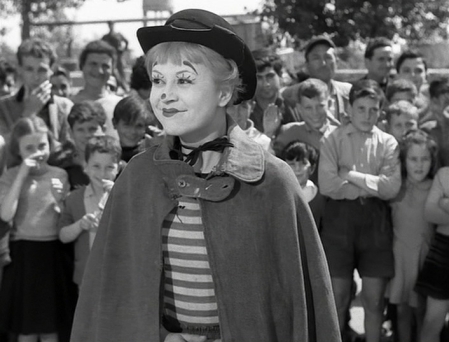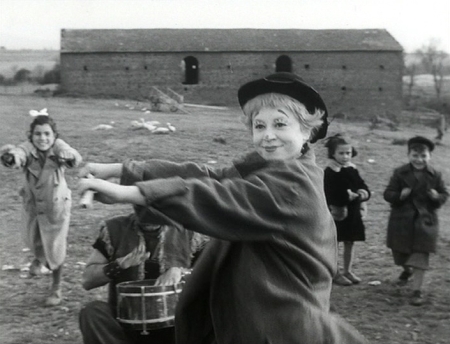
The Di Costanzo family is in dire straits. Abandoned by her husband, Mrs. Di Costanzo (Anna Primula) has so little money that she and her many children can’t even afford to eat every day. To make matters worse, a man named Zampanò (Anthony Quinn) shows up with some devastating news: One of the family’s daughters, Rosa, who had been working as Zampanò’s assistant in his traveling strongman act, has died. In the midst of her grief, Mrs. Di Costanzo offers him another daughter, Gelsomina (Giulietta Masina) — an odd, childlike young woman — as a replacement. “I told you, she’s not like Rosa,” her mother says to Zampanò. “But she’s a good girl, poor thing. She’ll do what she’s told. She just came out a little strange.” Then she appeals to Gelsomina herself, pointing out that she’ll get to learn a trade and see the world, not to mention easing the family’s financial burden. Gelsomina seems uncertain at first and wanders away from her mother and siblings, but once her back is turned on them, she smiles. Thus, full of excitement, she sets out with Zampanò at the start of Federico Fellini’s 1954 film La Strada — Italian for “the road.”
If Gelsomina thinks her new life will be glamorous, she’s sorely mistaken. Her home is now Zampanò’s rickety motorcycle and wagon hybrid, in which the two of them travel the country, stopping here and there to perform their act and collecting a few lire from the small crowds that congregate to watch. Still, she seems to get a thrill out of it. Everything is a novelty, even a meal at a shabby restaurant. She looks around, eyes wide with fascination and pleasure, and then orders both the lamb and the veal; no doubt she never ate so well when she lived with her family.

Working with Zampanò also gives Gelsomina an unprecedented sense of purpose. “I’m gonna work and learn a trade and send money home. I’m gonna be an artist too,” she declares early on in the film. Zampanò’s main trick, repeated at show after show, involves putting an iron chain around his chest and straining until one of the links breaks. When Gelsomina first joins him, he hands her a drum and tells her to introduce him with the line “Here he is: Zampanò” — and she can’t even do that correctly, much to his irritation. Before long, though, she’s moved beyond merely introducing him. Decked out in a bowler and clown makeup, she acts as Zampanò’s foil in a comedy routine; later, at a wedding reception, she gets to perform a solo dance while he takes over the drum. It’s striking to see how she comes out of her shell in these scenes, how much delight she takes in entertaining an audience and receiving positive feedback. “All the clowns I have ever known took great pride in their work and understood that being funny is serious business,” Fellini told author Charlotte Chandler in an interview for her book I, Fellini. “I personally, through my life, have admired totally the person who can make others laugh. That seemed to me both worthwhile and difficult.” Like the young Fellini, who became fascinated with clowns after his first visit to a circus at age seven, children in La Strada are particularly drawn to Gelsomina. Whether they regard her as an equal or just think she’s funny, they immediately treat her like a friend.

Unfortunately, the nature of Gelsomina’s work makes it all but impossible to form enduring friendships, because she never stays anywhere for more than a day or two. At one point, she and Zampanò join a circus, which gives her the opportunity to become part of a community — the owner, Giraffa (Aldo Silvani), describes it as “one big family” — but Zampanò’s bitter rivalry with another performer, the Fool (Richard Basehart), spoils that for her. The only constant presence in her life, then, is Zampanò himself, and he’s far from an ideal companion. A brutal man, he treats her cruelly at every turn, sometimes through demeaning comments, sometimes through neglect and outright abandonment, sometimes through violence. (It’s never made clear how her sister Rosa died, but it’s hard not to wonder if Zampanò was at fault.)
Gelsomina grows to resent his behavior toward her, yet she never leaves him for good, though she has her chances. Maybe it’s due to an understandable lack of self-respect; even the Fool, who becomes the closest thing she has to a friend, makes unkind remarks about her. (“What a funny face you have. Are you sure you’re a woman? You look more like an artichoke.”) Maybe it comes from a sense of duty or obligation, as Zampanò essentially purchased her from her family for ten thousand lire. Maybe it’s something simpler still: a fundamental urge to connect with another person, to be important to somebody. In 1962, Fellini said of his films, “There is an effort to show a world without love, characters full of selfishness, people exploiting one another, and, in the midst of it all, there is always — and especially in the films with Giulietta — a little creature who wants to give love and who lives for love.” To the audiences they meet in their travels, Gelsomina and Zampanò provide comedy and thrills; to the audience of La Strada, they provide a universal human tragedy in microcosm.
Sources
Chandler, Charlotte. I, Fellini. New York: Cooper Square, 2001.
Fellini on Fellini. Trans. Isabel Quigley. Da Capo, 1996.
This post is part of the At the Circus Blogathon, hosted by Crìtica Retrô and Serendipitous Anachronisms. Click the banner above to see all of the other great posts.


Erin- Thank you for your contribution to #AtTheCiircus, this is one of my favorite films and I really look forward to reading your post!
-Summer
LikeLiked by 1 person
Thanks for hosting!
LikeLike
When I was a child it was called “Road to La Strada” years ago when The late show (movies only back then) was on all I remember is about a sad little lady who wanted to be treated good and how Anthony Quinn mistreated her but I was too young it made me sad. I finally got to watch it again in my ’70s. It confirmed my feelings sad tear jerker & anger how a man could treat her as his servant/slave. Same feeling what was the purpose of this storyline?!
LikeLike
Pingback: At The Circus – Blogathon – Serendipitous Anachronisms
Hi Erin. Isn’t Giulietta Masina wonderful? This is my favorite Fellini movie. I’m glad you included his comment about his movies: “There is an effort to show a world without love, characters full of selfishness, people exploiting one another, and, in the midst of it all, there is always — and especially in the films with Giulietta — a little creature who wants to give love and who lives for love.” I enjoyed your review.
LikeLiked by 1 person
Thank you! Yes, I love Giulietta Masina, and this is one of my favorite Fellini movies too. It was actually the first Fellini that I ever saw, and I think it’s a good starting point.
LikeLike
This film is heartbreaking – nad my heart was broken once more when I found out that the main theme song was played at Giulietta’s funeral.
I loved the last paragraph, about a loveless world still with creatures wanting to give love: it perfectly sums up Gelsomina’s situation.
Thanks for joining us, Erin, it was great to have you among our guests!
Kisses!
Le
LikeLiked by 1 person
You’re welcome, and thanks for hosting! Yes, I remember reading that she had the theme song played at her funeral; the film must have meant a lot to her. I agree, too, about the quote, which also fits her character in Nights of Cabiria very well.
LikeLike
Erin, I always love your posts, they are so thoughtful. This is such a lovely and heartbreaking film. You managed to hit on the emotional content so well. Great post! Thank you for your fabulous contribution to #AtTheCircus!
LikeLiked by 1 person
Thank you so much! I really appreciate the compliment, and I’m glad you enjoyed the post. Thanks, too, for hosting the blogathon!
LikeLike